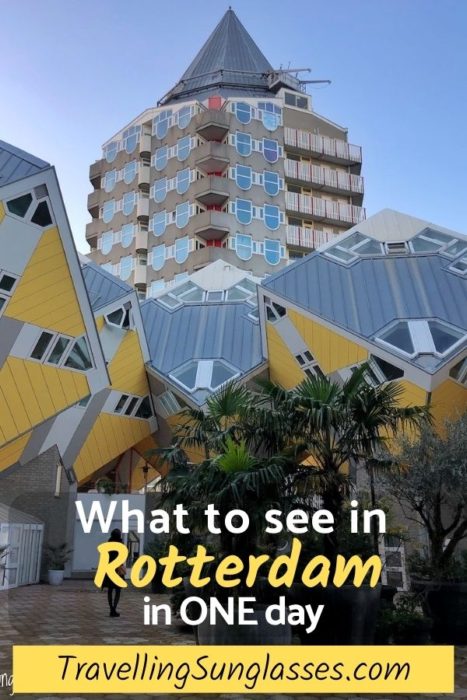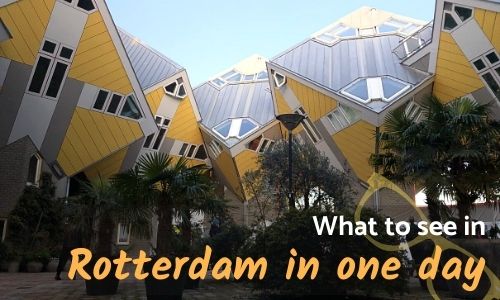Rotterdam is perfect for a day trip or a city-break. Whether you are visiting other cities in the Netherlands, or you travel to Rotterdam on purpose, there is much to see.
This Dutch city was a real surprise for us: our trip to Rotterdam was to visit friends, and we had zero knowledge about the city and its attractions. Consequently, we were completely charmed by this city and its extremely contrasting architecture, ranging from traditional old streets to exciting modern structures.
If you are passionate about architecture, definitely dig deeper and plan an efficient itinerary. But if you want to be surprised at every other corner, then be spontaneous like us and read below the best places to visit in Rotterdam in one day.
Also, if you wish to spend the night, find here advice about the best hotels and hostels in Rotterdam!
Planning a longer stay in the Netherlands? Have a look at the best things to do in Amsterdam in one day.
Quick history of Rotterdam
A visit to Rotterdam is much more enjoyable with a bit of historical context.
What remains of Old Rotterdam? Well, consider that settlements at the end of stream Rotte date back to 900 AD, approximately. Already back then, floods threatened development, which led to the construction of a dam on river Rotte in the 1260s. See how the name of the city came to be?
During the centuries, trade fostered the development of Rotterdam, its port leading the growth. The end of the 1800s constitutes the most important spur of growth: the Witte Huis, mentioned below, was built in this period.
During World War II, on 14 May 1940, the German Luftwaffe almost completely destroyed the heart of Rotterdam, a mere 4 days after the army invaded the Netherlands. The Dutch army was forced to capitulate one day later, under the threat of bombing other cities. The City Hall and St. Lawrence Church survived the bombing.
This is how Rotterdam came to be such a hub of modern architecture: the Rotterdam Blitz created the opportunity of a new architectural landscape. The city was gradually rebuilt from the 1950s to the 1970s, but it wasn’t until the 1980s that an active architectural policy was developed by the authorities. The city centre became more livable, thanks to modern and groundbreaking new styles of apartments, office buildings and recreation facilities.
Nowadays, Rotterdam is the 2nd largest city in the Netherlands, Europe’s largest seaport, and it is known for its university, its lively cultural life and its modern architecture.
Map of what to see in Rotterdam in one day
Make use of our map! Let us know in the comments how we can improve it.
Modern Rotterdam is blue; Old Rotterdam is purple; Natural Rotterdam is green.
Modern Rotterdam
It is definitely possible to visit many modern Rotterdam landmarks in just one day.
Cube houses (Kijk-Kubus)
Let’s get started with the most famous landmark in Rotterdam: the Cube Houses!
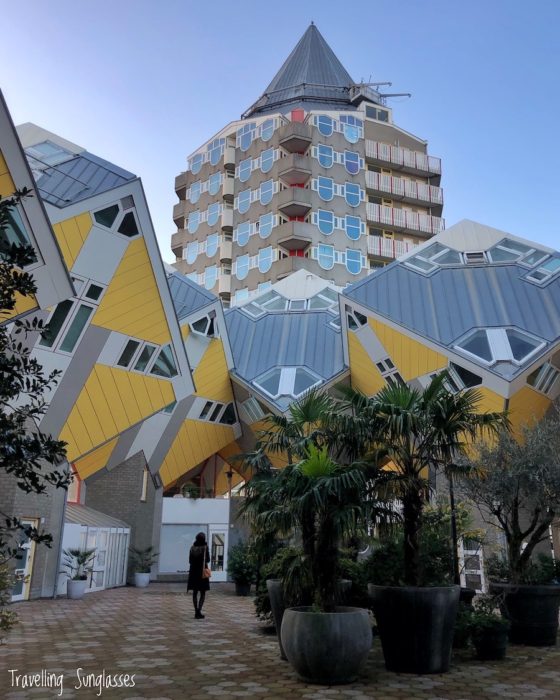
Dutch architect Piet Blom designed them in the 1970s as his answer to building housing above a pedestrian bridge. He also designed the pencil-looking building right next to the Cube Houses.
Located right in the city centre (map here), near the Market Hall, they will leave you with your mouth open.
These bright yellow cubes are perched on top of cement pylons and tilted at a 45-degree angle, which makes them look more like sculptures of an urban jungle, or a spaceship, than actual homes.
Instead, almost all of them are inhabited! One is even a hostel. You can visit one of them at the price of 3 EUR (check the current opening hours here). Each room has an unexpected geometric shape, the ceilings are tilted, the windows are not where you expect them to be. It’s a really absurd and entertaining visit.
Take your time to walk below the Cubes, to explore the courtyards and discover the artistic geometries composed by the edges.
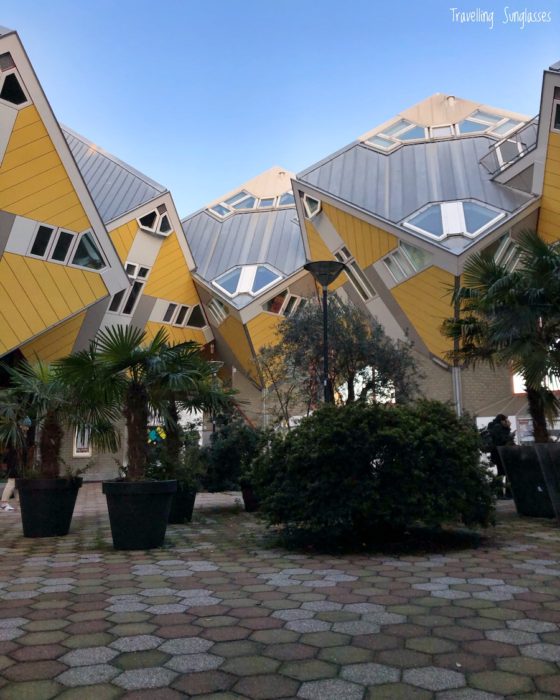
The Market Hall (Markthal)
Another impressive modern building is the Market Hall, opened in 2014 by the Queen of the Netherlands herself.
Located right in front of the Cube Houses (map here), the spacious square in front of it allows you to admire its sheer size: the roof reaches 40 meters of height!
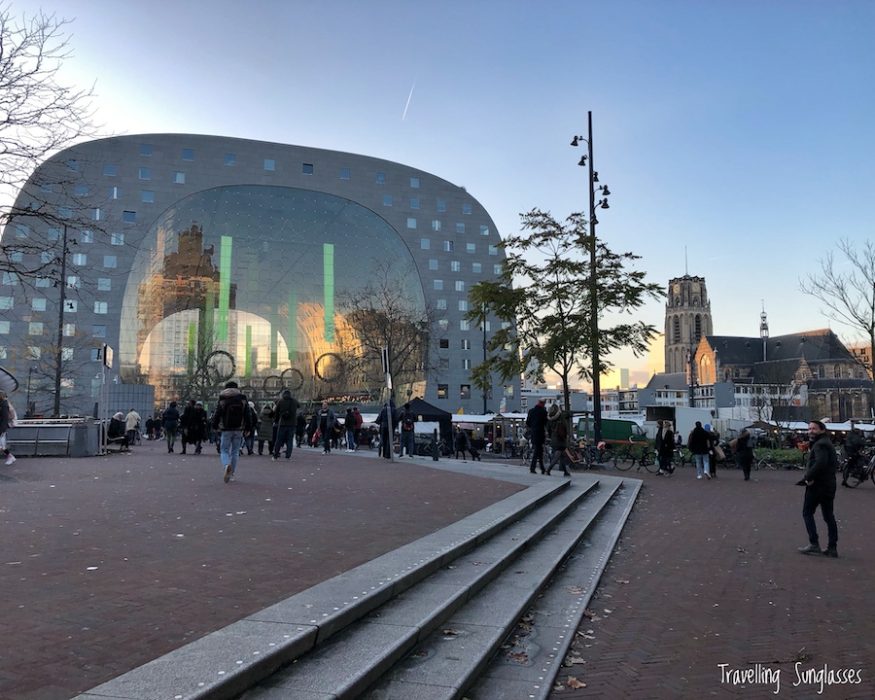
The centre of the reversed horseshoe-shaped building is a gigantic glass facade.
Once you enter the market, it’s very hard to focus your attention: the immense arched ceiling and walls around you are decorated with fruits and vegetables, seeds, flowers, insects and fish (artwork by Arno Coenen and Iris Roskam).
At the same time, rows and lines of kiosks and stands invite you over with delicious smells: local specialities like Stroopwafels, but also international dishes from the Balkans to Indonesia. I wanted to taste everything!
Underground, there are more shops and the largest parking in Rotterdam, while above, more than 200 apartments are embedded in the structure of the horseshoe.
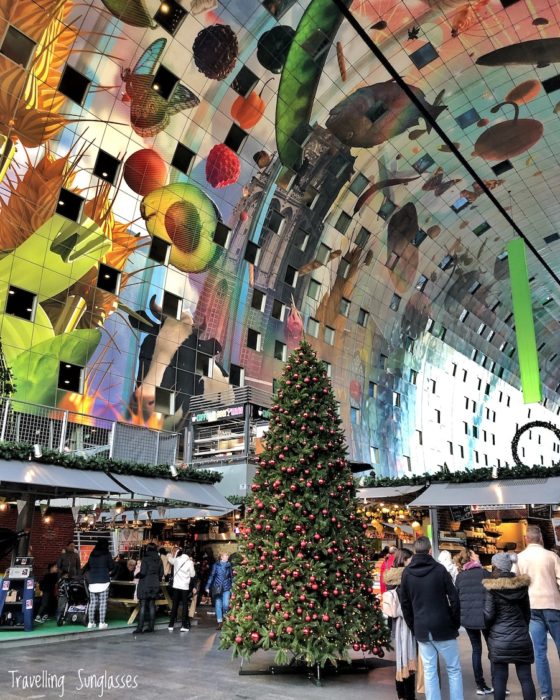
Erasmus Bridge (Erasmusburg)
Located here (map) between Rotterdam city centre and the Southern part of the city, Erasmus Bridge is aptly named “The Swan” after the sleek and slender lines of its supporting pylon.
With its 802 meters of length across the New Meuse river, it ranks as the second-largest bridge in the Netherlands.
The view from the Northern bank, coming from the city centre, is truly impressive: behind the delicate Erasmus Bridge, the unique De Rotterdam skyscrapers stand proud. Definitely a postcard view of two Rotterdam landmarks! If you can, make sure you pass by here both during the day and the night, to enjoy also the night illumination.
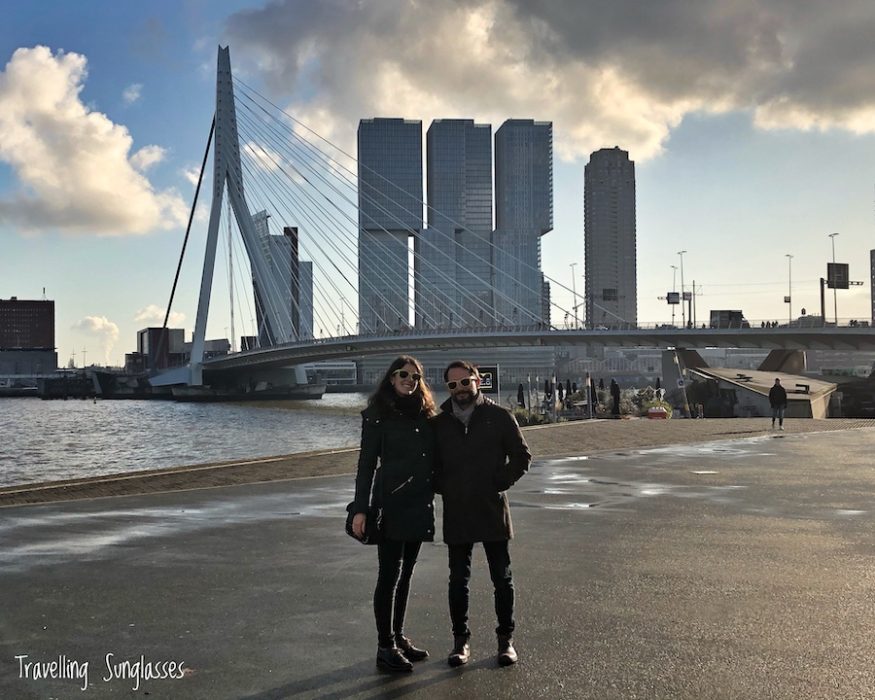
De Rotterdam skyscrapers
Remember Legos? Well, to be honest, at first glance the three skyscrapers of De Rotterdam reminded me of a childish attempts to build a tower with Legos!
To be precise, the three towers are connected, thus making De Rotterdam a single building. Designed by Rem Koolhaas and finalized in 2013, the building houses offices, apartments and even 4-star hotel nhow Rotterdam.
The structure and the facades are built so that, from a car or a boat, they keep changing appearance. For engineers and architects, De Rotterdam is a must visit (map here).
Street art
Here’s your new profile picture!
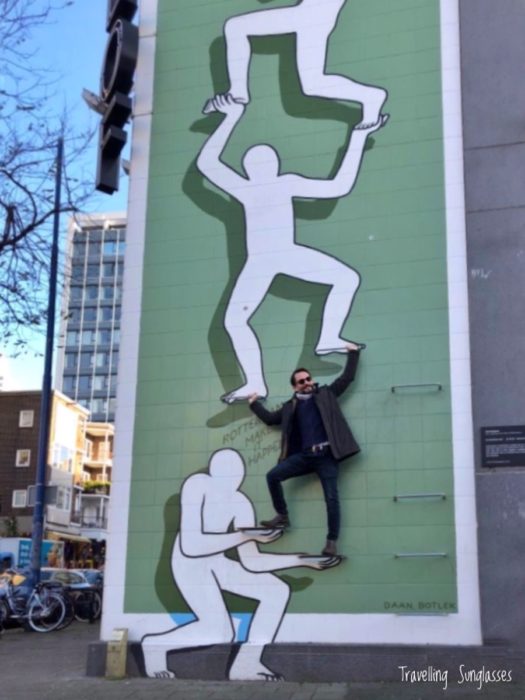
Explore and interact with the colorful murals along Witte de Withstraat (literally Whitey the white street, map here). “Make it happen” by Daan Botlek is super fun: you can even climb a couple of steps and join a human tower until the roof, like Darek in the picture!
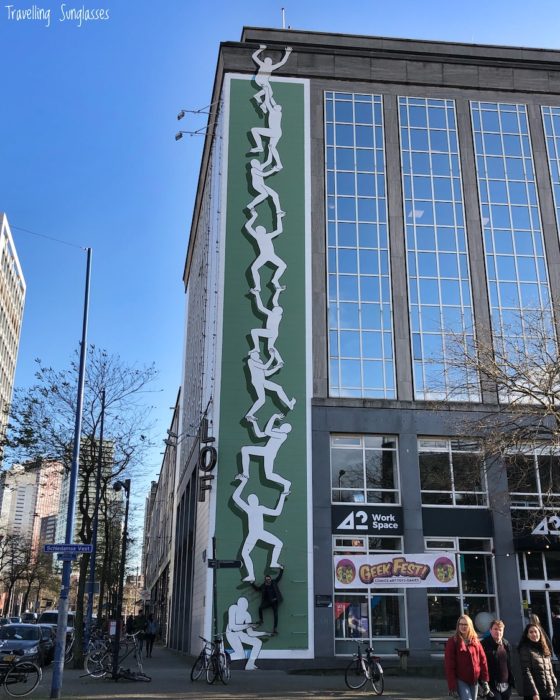
Besides the street art, this area is popular for its nightlife, cafés and restaurants. It’s perfect for spontaneous exploration.
You can find more cool street art on this excellent website.
Santa Claus Statue by Paul McCarthy
Yes, it was nicknamed “The Buttplug Gnome”, but no, that wasn’t the intention! This statue by American sculptor Paul McCarthy is supposed to depict Santa Claus holding a Christmas tree.
After the initial shock, the controversy started to spark interest, and the statue is still standing today, attracting curious visitors strolling along Oude Binnenweg street (map here).
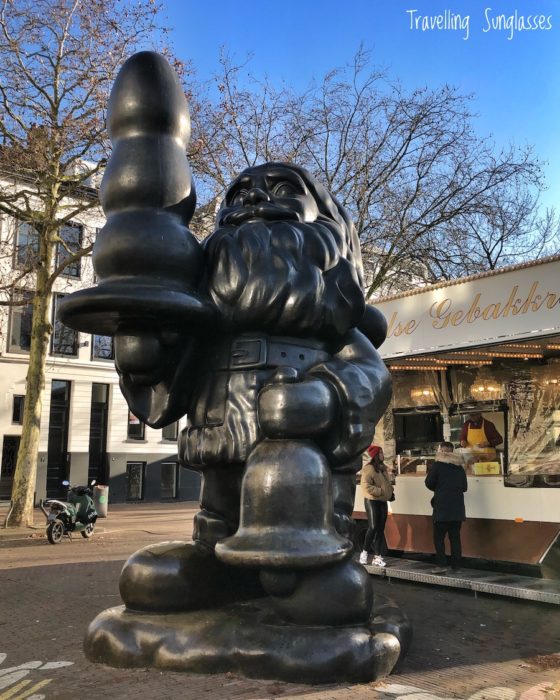
More modern buildings in Rotterdam
You may want to keep an eye out for:
- The Timmerhuis
- Rotterdam Central Station
- Luchtsingel Bridge
- St. Paul’s Church
You may also be interested in more ideas for city breaks!
Old Rotterdam
If you also love traditional European architecture, dom’t worry, you can get your dose during your one day in Rotterdam.
City hall (Stadhuis)
Located in the city centre (map here), Rotterdam City Hall is one of the few buildings that survived the bombing raids of World War II.
It was built between 1914 and 1920, together with a renovation of the inner city and its boulevard, due to the rapid growth of the city. The 71-meter-high tower rises in the centre of the classy facade, constructed in neo-Renaissance style influenced by neo-Romanesque and neo-Byzantine elements.
The inner courtyard houses a beautiful garden with a fountain, which unfortunately we did not visit. As it is an active government building, it can be visited inside only with a guided tour.
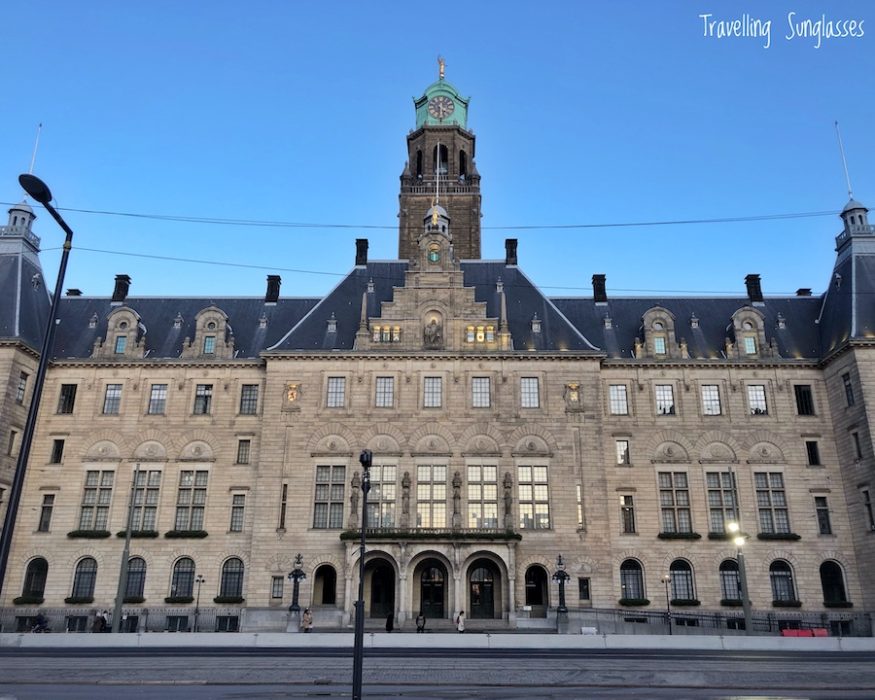
St. Lawrence Church (Sint-Laurenskerk)
The contrast with the adjacent Market Hall couldn’t be stronger! Isn’t it exciting to visit a city that shows the passing of the centuries so clearly? (map here)
The Church of St. Lawrence is the only remaining building in medieval architecture. Even though it was damaged during WWII, its reconstruction became a symbol of the rebirth and perseverance of the city.
Originally constructed in 1449, it’s located by the original settlement, making it the birthplace of Rotterdam!
You can have a look at the interior of the church, at its high arches and imposing vaults, but a ticket fee is required to visit the church.
White house (Witte huis)
Another survivor of the WWII bombings, Witte huis (map here) was once Europe’s tallest building with its 45 meters!
Built in 1898 in Art Nouveau style, it keeps alive the city’s heritage and history with its beautiful white facade and ornate turrets. I love the contrast with the nearby red and modern bridge!
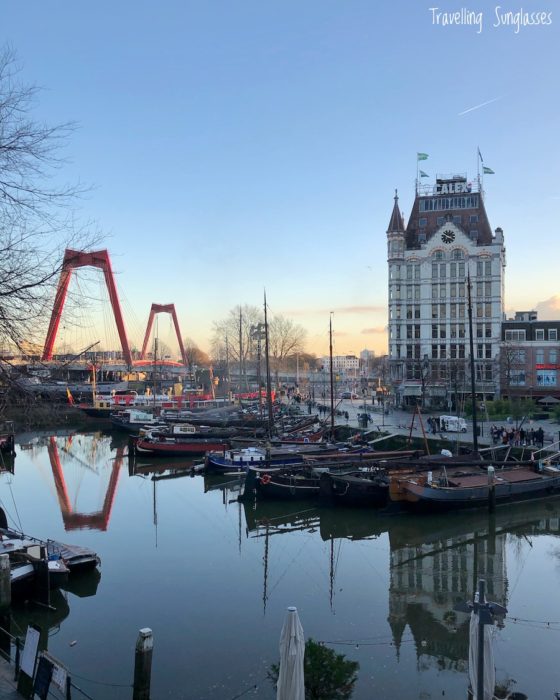
Oude Binnenweg and Witte de Withstraat
There’s a reason why I loved Oude Binnenweg street (map here) so much: it’s the only shopping street remaining from before the war. The facades were renovated to white and simple styles, or red with bricks, or decorated with Art Nouveau details, in a beautiful alternation. Melief Bender pub and Café Timmer deserve a visit.
Witte de Withstraat street (map here) looks similar, but even more lively with cafés and restaurants, benches and tables, and colourful street art.
More historical landmarks in Rotterdam
Not enough historical vibes? Check out also:
- The historic town centre of Delfshaven
- Hotel New York
Natural spots in Rotterdam: Kralingse Plas and the windmills
If you’ve had enough of the city and the crowd, head out to the picturesque lake of Kralingse Plas (map here).
Relax and enjoy nature along the lake-side path, between the trees and on cute little bridges. In particular, on the western side, you will find “De Lelie”, a classic Dutch windmill.
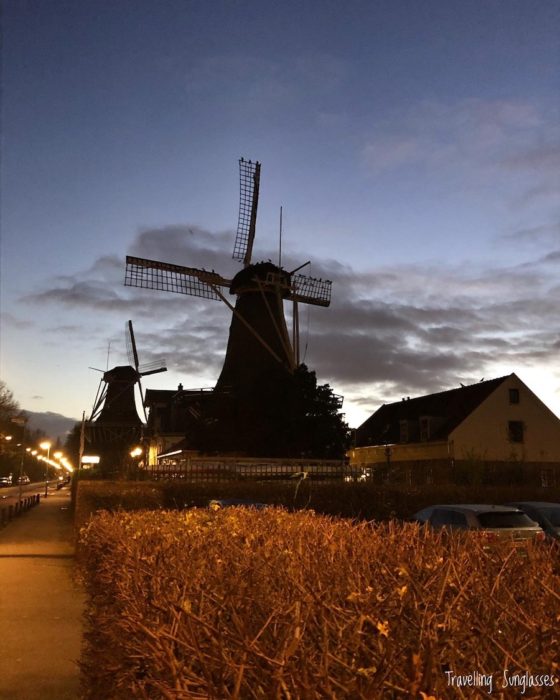
Furthermore, the sunset from Restaurant De Schone Lei is worth the walk: beyond the peaceful lake, the lights of the city’s modern skyline glimmer in the dusk.
If you want even more windmills, head over to UNESCO Heritage site Kinderdijk, located slightly outside Rotterdam (map here)
Conclusion
It’s easy to conclude that Rotterdam will keep you busy for a full day very easily. Every street will surprise you with more modern, futuristic buildings, in stark contrast with old stone facades full of memories.
Are you planning to travel to Rotterdam? Let us know in the comments!
